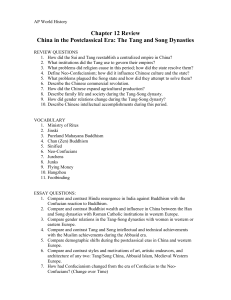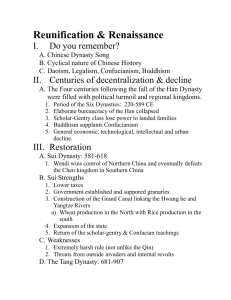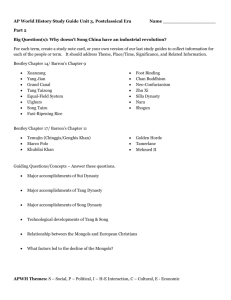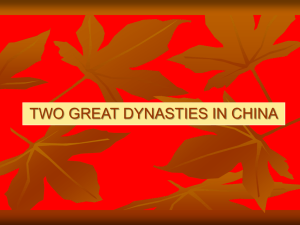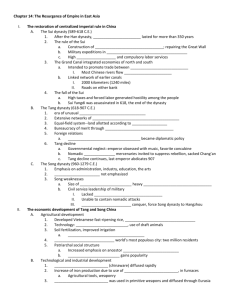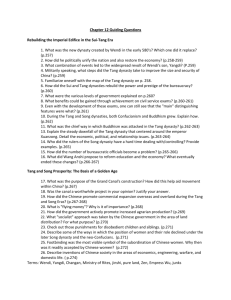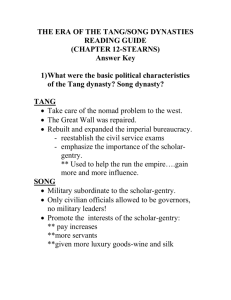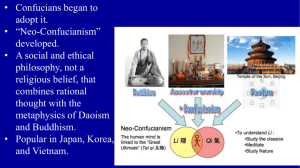tang dynasty - Sharyland High School
advertisement
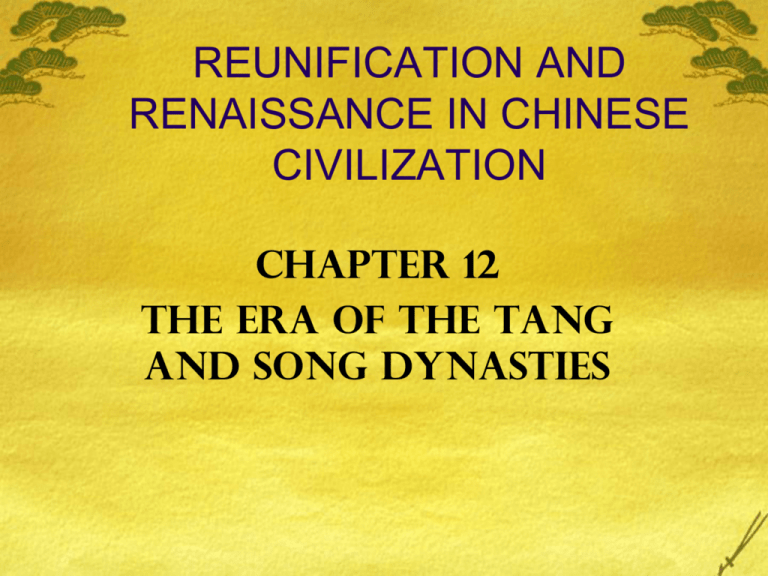
REUNIFICATION AND RENAISSANCE IN CHINESE CIVILIZATION Chapter 12 THE ERA OF THE TANG AND SONG DYNASTIES 220 End of Han Dynasty 220 – 589 Era of Division; time of greatest Buddhist influence 589-618 Sui Dynasty; building of Grand Canal 618-907 Tang Dynasty 690-705 Empress Wu; Buddhist influence in China peaks 712-756 Xuanzong emperor 840s Period of Buddhist persecution 907 End of Tang Dynasty 960-1279 Song Dynasty; NeoConfucian revival 1050 Invention of block printing and moveable type 1067-1085 Shenzong emperor; reforms of Wong Anshi 1100 Invention of gunpowder 1115 Jurchen (Qin) Kingdom in North China 1127-1279 Southern Song Dynasty 1279-1368 Mongol (Yuan) Dynasty rules all of China AFTER THE HAN Called Era of Division or Six Dynasties Period—all est. capitals at Nanjing Period marked by nomadic domination & economic decline Confucianism replaced by Buddhism Trade & cities decline as nation is decentralized Rebuilding the Imperial Office Sui dynasty 589-618 CE Wendi, a northern aristocrat, successfully unified N. and S. China through conquest Wendi – from prominent Chinese Noble family Secured power by winning support of neighboring nomadic military commanders (showed little desire to favor Confucian scholar-gentry class at their expense) Reunited traditional core areas of Chinese civilization for the first time in three and a half centuries won support by lowering taxes and establishing granaries throughout domains Sui Excesses and Collapse Yangdi, murdered his father (Wendi) and seized the throne Extended father’s conquests Continued the process of political reunification and centralization Drove back nomadic intruders who threatened northern frontiers Milder legal code Devoted resources to Confucian education Restore examination system Promoted scholar-gentry Yangdi was fond of luxury and extravagant construction projects Forcibly made hundreds and thousands of peasants build palaces, a new capital city (Loyang) Built a series of great canals linking various parts of empire Grand Canal Bring food supplies from the south to the north Linked the Yangtze and the Huang-Hi 611-615 : Led his exhausted and angry subjects into a series of unsuccessful wars to bring Korea back under Chinese rule Set in motion widespread revolts Provincial governors declared themselves independent rulers, bandit gangs raided at will, and nomadic groups seize large sections of north China 618 - Yangdi assassinated by his own ministers Emergence of the Tang Li Yuan established the Tang dynasty. Secured the Chinese frontiers from the Turks Laid the basis for the golden age of the Tang Tang armies conquered deep into Central Asia (as far as Afghanistan) Impact of victories? Many of the nomadic peoples who dominated China in the Six Dynasties era had to submit to Tang rule Turkish tribes posed greatest threat Tang emperors also completed repairs begun by Sui dynasty on Great Wall Created frontier armies 668 – Emperor Kaozong (creates vassal Kingdom called Silla in Korea) Tang built empire much larger than Han Building A Bigger, Better Empire •Tang exploited trade along the Silk Road, established territories in Central Asia to protect the goods traveling back & forth Rebuilding the Bureaucracy Monarchs fully restored the imperial bureaucracy Confucian scholar-gentry continued to dominate. Civil service examination greatly expanded Highest offices could only be gained by those able to pass exams on philosophical or legal classics special social status The role of aristocratic families within the government declined. The Bureau of Censors constantly evaluated the work of civil servants at all levels of the administration. Still… birth and family connections continued to be important in securing high office Established bureaucrats not only ensured that their sons and cousins got into the imperial academies but could pull strings to see that even failed candidates from their families received government posts Corruption??? The Growing Importance of the Examination System The Ministry of Rites administered increasingly regularized examinations to students Those who passed the most difficult exams were declared jinshi and granted opportunity to achieve high office Success in the examination procedure granted higher social status to the candidates State and Religion in the Tang-Song Era Increasing state support for Confucian learning threatens old aristocratic families and Buddhists (had become a major force in Six Dynasties era) Many Pre-Tang rulers – devout Buddhists (especially the nomadic ones) Mahayana Buddhism – supported by the masses since it provided refuge from an age of war and turmoil Chan (Zen) – attracted members of elite; stress on meditation and appreciation of natural artistic beauty; goalcome to know ultimate wisdom and find release from cycle of rebirth (through reflective meditation) Buddhism was a strong force (socially, economically, and politically) by the time of Tang unification Early Tang rulers – support Buddhism; promote education of Confucian classics Empress Wu (690705) – major supporter of Buddhism Buddhism Takes A Beating •Daoist & Confucian officials resent the tax & military exemptions for Buddhist monasteries •Wuzong c.845 persecutes Buddhists; monks forced to abandon land and monasticism •Monasteries permanently lost their influence over politics, but the faith would endure •Buddhism left its mark on the arts, Chinese language, and Chinese thinking about things such as heaven, charity, and law Tang empire was immense covering Korea, Manchuria, and parts of Central Asia. Used a census and built public works. A fixed amount of land was given to most male citizens. Known for : Architecture Sculpture, painting, literature, art, and porcelain Unique form of garden designed for peace and contemplation Key was their development of block printing Encouraged commerce making the Silk Road busy TANG DYNASTY Country of Origin: Tan'g China Date of Origin Tang Dynasty late 8th century Use: Funeral figure. These were common in the late 8th century in China. They were used as figures in "Heavenly Horse". tombs. The horse is not a typical horse of 8th century China but is a heavenly horse. Emperor Xuanzong (713-756) – marked the peak of Tang power and high point of Chinese civilization Initially… strong interest in political and economic reform But over time… devoted himself to the pleasures available within the confines of the imperial city Xuanzong’s long neglect of state affairs resulted in economic distress, chronic military weakness (all of which left government unable to deal with disorders effectively) None of the leaders that followed Xuanzong could compare with the able leaders the dynasty had earlier Tang Decline Tang decline actually began in the eighth century as a result of disruptions within the imperial family. As central authority weakened, nomads on the frontiers gained control over large portions of China and generals were able to establish regional kingdoms. After Tang, it appeared China was entering another phase of nomadic dominance, political division, and social conflict 960 – Emperor Taizu defeats all rivals except one (Liao Dynasty – founded in 907 by nomadic Khitan peoples from Manchuria) Shows weakness of Song rulers 1004 – Song forced to sign treaties with smaller yet more militarily adept northern neighbors (Liao empire) Forced Song to pay very heavy tribute to Liao Dynasty to keep it from raiding and possible conquering Song domains Song Politics: Settling for Partial Restoration Song never matched its predecessor (Tang) in political or military strength Military subordinate to civilian administrators of scholar-gentry class Song rulers strongly promote interests of Confucian scholar-gentry Officials within class receive higher salaries, additional servants, payments of luxury goods (silk and wine) Bureaucracy soon became bloated with well-paid officials who often had little to do Rise of Neo-Confucianism •Revival of Confucian principals during Song •Wary of foreign faiths (i.e. Buddhism) •Emphasized tradition and the pursuit of virtuous morality through ancient texts and the teachings of wise men (eventually hurt innovation and critical thinking among Chinese elite) •Stressed Confucian social stratification! •If men and women kept to their place and performed the tasks of their age and social rank, there would be social harmony and prosperity •The past is man’s best example for future Roots of Decline: Attempts at Reform Weakness showed in face of Khitan challenge encouraged other nomadic peoples to carve out kingdoms on northern borders of Song domains Tribute was great drain on resources and growing burden for peasantry Equally burdensome was cost of army (nearly 1 million soldiers) need to guard against invasion from north Emphasis on civil administration and scholar-gentry class, along with the lack of support for military took a toll 1070s – Wang Anshi (advisor to Emperor Shenzong) attempts reforms Legalist Cheap loans Government assisted irrigation Taxed landlord and scholarly classes Mercenary forces to replace army Education reform Reaction and Disaster: Flight to the South 1085 – Emperor Shenzong dies (Wang loses support) and reforms are opposed Neo-Confucians come to power (reversed many of Anshi’s reforms) Economic conditions deteriorate, peasant unrest grew throughout empire, banditry and rebellion from within, and military no match for increasing threat beyond northern borders of empire 1115 – New nomadic group, the Jurchens, overthrew the Liao dynasty of the Khitans and established the Qin Kingdom north of Song Empire Conquests forced Song to flee to south Southern Song (1127-1279) It’s brief reign was to be one of the most glorious in Chinese history Tang and Song – Golden Age Grand Canal – designed to link original centers of Chinese civilization on the north China plain with the Yangtze River basin more than 500 miles to south Made it possible to transport grain from the fertile southern regions and to transfer food from the south to districts threatened by drought and famine in the north More than 1 million forced laborers had worked on the project, many died Engineering achievement (on the same level as Great Wall) 1200 miles long, 40 paces wide The Grand Canal, connecting Beijing, Hwang Ho(Huang He), and Yangtze River, was used to ship grain within China. inventions Tang-Song Commercial Revolution •Tang conquests in central Asia and the building of canal system promoted commercial expansion in Tang and Song eras •Overland silk routes between China and Persia were reopened and protected •Imported – Horses, Persian rugs, tapestries •Exported – silk textiles, porcelain, and paper •Increase in trading ships •Chinese junks were best ships in the world •Equipped with watertight bulkheads, sternpost rudders, oars, sails, compasses, bamboo fenders, and gunpowder rockets Tang-Song Commercial Revolution •Market quarters found in all cities and major towns •Abacus allowed for more complicated accounting practices; bigger business •Renewed government centralization allowed for a greater degree of economic organization •First use of paper money during Tang •Flying money Land Reforms Fuel the Economy •Land reforms would allow peasants a greater degree of economic freedom than before •Equal Field system divided land among peasants in return for taxes in grain, textiles, labor (20 days a year), & military service •Agricultural boom would feed economic innovation in the cities Interregional Trade & the Merchants •Merchants would gain more acceptance as the scholar-gentry became actively involved in commerce •Merchants could even join the gentry class •Merchants would foster regional specialization in goods; took advantage of existing infrastructure (roads, Grand Canal) •No longer limited to govt. marketplaces A MARKET ECONOMY Merchants in Charge Financial instruments Banking and credit institution “Flying money " were letters of credit Paper money backed by state, treasury A cosmopolitan society Only period in China where merchants socially superior to aristocrats Merchants attempted to intermarry with aristocrats, become landowners Merchants attempted to have sons admitted as Confucian bureaucrats Merchants tended to espouse Confucianism as way into traditional elites Most large cities had large merchant communities Foreign merchants in large cities of China Mostly Arab (Muslim), Indian, S.E. Asian Chinese merchants journeyed throughout region Economic surge in China An economic revolution in China Made China the wealthiest nation in the world at time Promoted economic growth in the eastern hemisphere Trading Guilds (Hang) & Currency •Trading guilds (hang) handled the transport & sale of grain, salt, tea, and silk •Merchant banks 1st issued currency; credit vouchers •Govt. would issue paper currency of its own; flying money vouchers Rise of Commercial Capitals •Changan & Hangzhou became commercial centers; early industrial centers •Urban population grows to nearly 10% •Hangzhou was an important port city; had goods from all over the world Industrial Production •Silk/cotton textiles, metal, ceramics and printing industries important •Govt. benefits from increased tax revenues; population benefits from increased economic opportunities in the major cities •Plantations industrialize agricultural prod. •Govt continues to subsidize grain & salt prices to ensure their accessibility TECHNOLOGY & INDUSTRY Porcelain Metallurgy Discovered by Daoist alchemists during the Tang Bamboo "fire lances," a kind of flame thrower, and primitive bombs Gunpowder chemistry diffused throughout Eurasia Printing Improvement: used coke instead of coal in furnaces to make iron, steel Iron production increased tenfold between the early 9th and 12th century Gunpowder High quality porcelain since the Tang, known as chinaware Technology diffused to other societies, especially to Abbasid Arabia Exported vast quantities to southeast Asia, India, Persia, and Africa Became common during the Tang From block-printing to movable type Books became widespread Naval technology "South-pointing needle" - the magnetic compass Double hulled junks with rudder, water-tight compartments Neo-Confucian Ideas About Women •Women were to be homemakers and mothers; Buddhist notions of a “careered” woman discouraged •Practice of footbinding personified subjugation of women •Curtailed movement; was a source of beauty •Rich & poor participated PATRIARCHAL SOCIETY Developments reinforced patriarchal society Chinese reaction to foreign ideas Preserving of family Family wealth became paramount Results Tightening of patriarchal structure Reinforcing of male domination Foot binding gained popularity during the Song Emphasized dependence of women on men, home Reaction to Buddhist’s gender equality Neo-Confucianism emphasized patriarchy Ancestor worship revived Wealthy, aristocrats could afford practice, hire servants to do work Feet of women broken, reformed around stilts Women could not walk without pain but had to shuffle Forced women to remain at home, dependent on others Male sense of beauty at women’s expense Poor, peasant women not subject to footbinding Women had to work with men to support family Men could not afford to have women at home, idle FOOTBINDING The custom of binding the feet of young girls painfully tight to prevent further growth. The practice probably originated among court dancers in the early Song dynasty, but spread to upper class families and eventually became common among all classes. The tiny narrow feet were considered beautiful and to make a woman's movements more feminine and dainty. Although reformers challenged the practice, it was not until the early twentieth century that footbinding generally died out, partly from changing social conditions and partly as a result of anti-footbinding campaigns. [1] Foot-binding resulted in lifelong disabilities for most of its subjects. In the 1990s and early 2000s, some elderly (born until the mid-1940s) Chinese women still suffered from disabilities related to bound feet A Glorious Age: Invention and Artistic Creativity Tang-Song remembered for accomplishments in science, technology, literature, and fine arts Tang – poetry and short stories Song – landscape painting Agricultural tools, banks, and paper money contributed to economic growth and social prosperity The Visual Arts of the Tang-Song Era •Landscape art became very popular; dedicated to natural depictions Regulated flow of water – Grand Canal, dikes, dams Bridges (most major bridge types known to humans were pioneered in China) Use of coal Tang – explosive powder First used mainly for fireworks Gradually… used by imperial armies in a variety of grenades and bombs Song armies and war ships equipped with flamethrowers, poisonous gases, and rocket launchers Song – compasses (aided in sea navigation; spread to Arab world) Abucas – ancestor of modern calculator (helped merchants count their profits and tax collectors keep track of revenues) Mid 11th century – block printing Remember… paper invented during Han Printing made it possible for them to attain a level of literacy that excelled that of any preindustrial civilization CHINESE DYNASTIC SONG Shang, Zhou, Qin, Han Shang, Zhou, Qin, Han Sui, Tang, Song Sui, Tang, Song Yuan and Ming and Qing Yuan and Ming and Qing Mao Zedong, Mao Zedong

